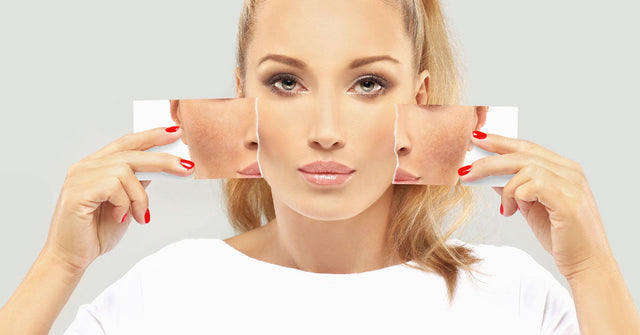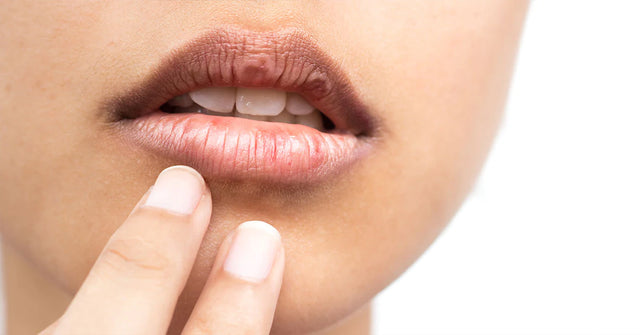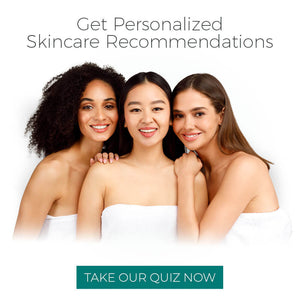Different types of acne, pimples, and breakouts affect most people at one point or another and many of us have had the frustrating experience of developing a giant pimple right before a big event!
In this age of social media, TikTok and Instagram are filled with videos of people sharing their tried and true secrets, favorite products, and home remedies to keep pimples at bay. However, no two people have exactly the same type of acne, so what may work for your friend may not work for you, and vice versa.
Figuring out the type of acne you have is the first step in successfully treating it. Here’s everything you need to know about the six different types of acne and how to get clear skin once and for all!
Non-Inflammatory Acne
We all recognize a red, inflamed pimple when we see one. However, unlike a bright red pimple, blackheads and whiteheads, which can be classified as comedones, clogged pores, or congestion, can be harder to spot at first glance.
These forms of non-inflammatory acne occur when a pore becomes clogged but doesn’t result in inflammation, redness, and swelling as it does with a traditional pimple. And, as noted above, while non-inflammatory breakouts may not be as noticeable as standard pimples, they can be harder to treat.
Here’s a deep dive into the two different types of non-inflammatory acne.
Whiteheads
Whiteheads form when dead skin cells, excess oil, and bacteria cause buildup in a pore, resulting in a white, non-inflamed head. Whiteheads are most common on areas of the face that produce more oil, such as the forehead and chin. Also known as ‘closed comedones,’ whiteheads differ from blackheads in the sense that they are closed off by a layer of skin, which is what gives the clogged pore its white appearance.
Blackheads
Similar to whiteheads, blackheads form the same way and are very common on the nose, as well as the forehead and chin.
The nose is covered with sebaceous filaments, the lining of the sebaceous glands that produce oil to keep our skin lubricated. It’s easy for our sebaceous filaments to become filled with excess oil and dead skin cells, and this results in blackheads. However, it’s important to note that not all sebaceous filaments are blackheads and vice versa.
Unlike whiteheads, blackheads are not sealed off by a layer of skin. They are considered ‘open’ pores or ‘open’ comedones and when the blockage is exposed to oxygen, it darkens, resulting in what we know as a blackhead.
Inflammatory Acne
Inflammatory acne causes red, inflamed pimples and can be hard to treat. These pimples seem to pop up around the worst of times – before a big date or important event, and for women, around the time of their period.
There are many contributing factors to inflammatory acne, but while dead skin cells and oil play a role, bacteria and hormones are usually to blame. Here’s a comprehensive breakdown of the different types of inflammatory acne.
Mild Types
Papules
Acne papules are the most common types of visible breakouts and are generally milder in severity. In appearance, they’re red, inflamed bumps and don’t often present a ‘head’ like other breakouts might. Papules are common on the face and various parts of the body and occur when the wall of a hair follicle ruptures. When this happens, it becomes easy for bacteria and dirt to fester in the pore, resulting in an acne papule.
Pustules
Most acne pustules start as papules. They form a white head that contains pus and fluid, hence their name, and usually occur on the face, back, buttocks, and chest, ranging in size and severity. It may be tempting to ‘pop’ them, but doing so can result in scarring and further infection of the affected pore.
Severe Types
Nodules
Painful, hard, and tender, acne nodules (or nodular acne) can occur as a result of acne-causing bacteria, excessive oil production, or changes in hormones. They are tough to treat and can sometimes be extremely painful.
Nodular acne is considered one of the most severe forms of acne and can cause scarring if left untreated.
Cystic Acne
Cystic acne occurs when large pimples and breakouts form deep within the skin. Often, a pore will become clogged due to hormonal influxes or bacteria which results in an infection below the skin’s surface level.
Cystic acne is considered severe and is mostly caused by hormones called androgens, which often flare up during puberty.
Skin Conditions That Are Similar to Acne
Acne is usually easy to identify and may be treated successfully with proper care and products. However, sometimes spots that appear like pimples can be due to a condition that mimics acne.
Skin conditions that often appear like acne can include:
Keratosis pilaris. A chronic skin condition that results in a red, bumpy skin texture, keratosis pilaris predominantly affects the body and is caused by keratin blocking the hair follicles. Folliculitis. Folliculitis is very similar to acne, occurring when hair follicles become inflamed and form tiny red pustules. Perioral dermatitis. This is a face rash caused by bacteria that can result in itching, burning, and fluid-filled blisters. Ingrown hairs. When hair grows into the skin instead of outward, it causes this condition that can look identical to either pustules or cysts, depending on the severity of the affected hair follicle.
Treating Different Types of Acne
Although acne is very common and affects roughly 650 million people worldwide, treating it requires diligent care and attention.
In mild to moderate cases, acne can usually be successfully treated at home with the right skincare routine, but if it’s more severe, it can require medical or dermatological intervention.
Medical Treatments
If you struggle with persistent cystic or nodular acne and have exhausted over-the-counter treatments, it might be time to visit a dermatologist who may suggest one of the following methods of treatment:
- Oral retinoids to treat nodular and cystic acne at the source
- Antibiotics
- Topical retinoids, like tretinoin or Retin-A
- Birth control pills
- Cortisone injections
Some people find a blend of medical treatments to be effective in more severe forms of acne and the sooner it is addressed, the less likely it is to cause painful breakouts and scarring.
Over-The-Counter Treatments
With the number of acne products flooding the skincare and beauty markets in recent years, it can be hard to determine which product is best suited for your needs.
Here are our top picks for the best over-the-counter acne treatments for both non-inflammatory and inflammatory acne.
Non-Inflammatory Acne Treatments
When dealing with blackheads, whiteheads, and clogged pores of any kind, thorough cleansing and chemical exfoliation are key, since oil and dead skin cell buildup are the primary causes.
While most cleansers remove makeup, dirt, and oil that collects in our pores throughout the day, if you’re struggling with blackheads or whiteheads, a clarifying cleanser containing exfoliating natural acids will eliminate pore-clogging buildup at the source.
Salicylic acid, a beta-hydroxy acid, works by dissolving excess oil and sebum within the pore lining. By cleansing with this oil-soluble exfoliating acid you ensure that all that pore-clogging debris is washed away!
Glycolic and lactic acids, alpha-hydroxy acids, work on the surface to dissolve dead skin cells that could otherwise lock in oil and impurities.
Exfoliating acids are the gold standard when it comes to dealing with blackheads and whiteheads since they can exfoliate within the pore lining and on the surface, compared to a scrub type of exfoliant.
Inflammatory Acne Treatments
If you’ve exhausted your options with other treatments, it might be time to incorporate a retinoid, considered the all-star multitasker in the skincare world.
Retinoids help acne by increasing cell turnover. While they’re considered to be keratolytic, meaning they dissolve dead skin cells, similar to chemical exfoliants, since retinoids increase your cell turnover, it leaves little room for bacteria, oil, and dead skin to fester for too long. They work much deeper within the skin to prevent acne at its source.
Unlike prescription retinoids, retinol is available over the counter. Using a retinol cream can be much gentler while still delivering results and by applying it in this form, you can mitigate sensitivity and potential irritation.
It’s important to remember that inflammatory acne is a result of inflammation within the skin, therefore, using soothing products rich in acne-fighting ingredients helps protect your skin barrier while cleansing your pores.
Treatment Solutions For Severe Acne
If you suffer from cystic or nodular acne, it might be time to visit a dermatologist, as previously mentioned. However, if you’re looking to clear existing, stubborn, painful breakouts, spot treatments and resurfacing treatments can help.
Using an at-home peel can help reduce cystic and nodular acne by removing dead skin cells and acne-causing bacteria, and lifting away impurities. Unlike blackheads and whiteheads, more severe forms of acne can benefit from a peel one to five times a week, depending on sensitivity.
Peels with concentrated amounts of salicylic, glycolic, and lactic acid can ease inflammation and accelerate cell turnover. Additionally, exfoliating acids can also fade hyperpigmentation caused by previous breakouts.
For stubborn pimples, resist the urge to pick and opt for a targeted spot treatment instead. Spot treatments containing sulfur are particularly effective since this ingredient has natural antibacterial, anti-inflammatory, and antifungal properties.
FAQs: 6 Different Types of Acne
Question One: What is the most common kind of acne?
Blackheads and whiteheads are the most common types of acne and virtually everyone experiences clogged pores at some point in their life.
Question Two: How do I know if my acne is hormonal or bacterial?
While acne can be both hormonal and bacterial, you’ll find that hormonal acne flares up during times of hormonal imbalance and tends to present itself on the cheeks, jawline, and chin, while bacterial acne is more consistent and can appear anywhere.
Question Three: How do I identify my acne?
Identifying acne is fairly simple once you understand what the different types of acne look like. If you’re not sure which type of acne you have, see a dermatologist.
Question Four: What’s the difference between acne and pimples?
Acne is a catch-all term for the symptomatology of different types of breakouts. Pimples, ranging from moderate to severe, are a form of acne.
The Takeaway
Acne is a broad term for various types of breakouts and pimples. By determining which type of acne you have, it’s easier to treat it at the source with targeted products.
We all deserve to have a clear, glowing complexion and with the right information, some TLC, and an effective skincare routine, healthy skin can be achieved!
Mentioned in this article
More stories

How Do Celebrities Lighten Their Skin Permanently?







